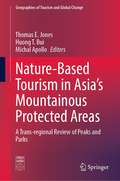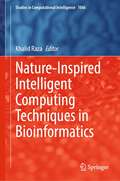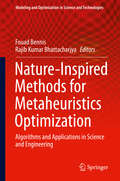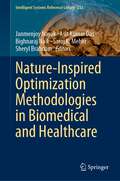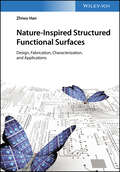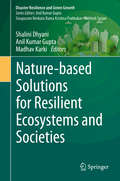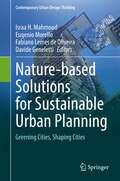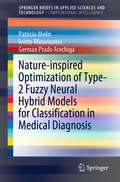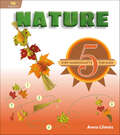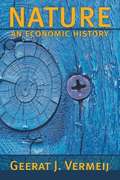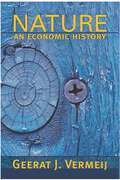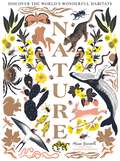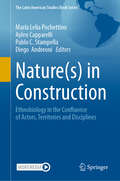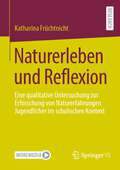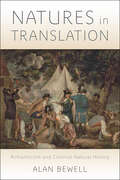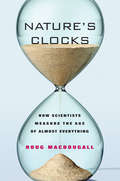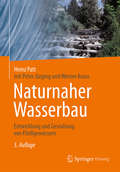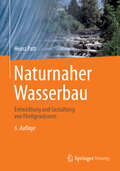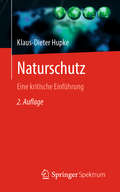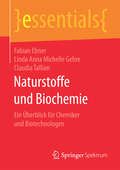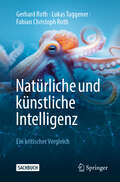- Table View
- List View
Nature-Based Tourism in Asia’s Mountainous Protected Areas: A Trans-regional Review of Peaks and Parks (Geographies of Tourism and Global Change)
by Huong T. Bui Michal Apollo Thomas E. JonesThis book provides holistic insights into management of protected areas across East Asia and identifies current trends in mountain tourism within the broader field of human geography and nature conservation. The book describes the diversification in visitors and expanding protected areas territories in different Asian countries during recent years. It also compares protected areas networks in the context of the changing demographic profiles of visitors and provides an interdisciplinary transnational appraisal of mountain-based tourism in Asia based on national and international statistics. The research combines specific case studies at the individual country and destination level with trans-regional trends, thereby offering analysis from both the perspective of supply (parks, protected areas, and stakeholders) and demand (mountain tourist market trends and segments). The book is a useful resource for students and academics in tourism and protected areas studies as well as social scientists and policy-makers interested in Asian countries.
Nature-Inspired Intelligent Computing Techniques in Bioinformatics (Studies in Computational Intelligence #1066)
by Khalid RazaThis book encapsulates and occupies recent advances and state-of-the-art applications of nature-inspired computing (NIC) techniques in the field of bioinformatics and computational biology, which would aid medical sciences in various clinical applications. This edited volume covers fundamental applications, scope, and future perspectives of NIC techniques in bioinformatics including genomic profiling, gene expression data classification, DNA computation, systems and network biology, solving personalized therapy complications, antimicrobial resistance in bacterial pathogens, and computer-aided drug design, discovery, and therapeutics. It also covers the role of NIC techniques in various diseases and disorders, including cancer detection and diagnosis, breast cancer, lung disorder detection, disease biomarkers, and potential therapeutics identifications.
Nature-Inspired Methods for Metaheuristics Optimization: Algorithms and Applications in Science and Engineering (Modeling and Optimization in Science and Technologies #16)
by Fouad Bennis Rajib Kumar BhattacharjyaThis book gathers together a set of chapters covering recent development in optimization methods that are inspired by nature. The first group of chapters describes in detail different meta-heuristic algorithms, and shows their applicability using some test or real-world problems. The second part of the book is especially focused on advanced applications and case studies. They span different engineering fields, including mechanical, electrical and civil engineering, and earth/environmental science, and covers topics such as robotics, water management, process optimization, among others. The book covers both basic concepts and advanced issues, offering a timely introduction to nature-inspired optimization method for newcomers and students, and a source of inspiration as well as important practical insights to engineers and researchers.
Nature-Inspired Optimization Methodologies in Biomedical and Healthcare (Intelligent Systems Reference Library #233)
by Sheryl Brahnam Janmenjoy Nayak Bighnaraj Naik Asit Kumar Das Saroj K. MeherThis book introduces a variety of well-proven and newly developed nature-inspired optimization algorithms solving a wide range of real-life biomedical and healthcare problems. Few solo and hybrid approaches are demonstrated in a lucid manner for the effective integration and finding solution for a large-scale complex healthcare problem. In the present bigdata-based computing scenario, nature-inspired optimization techniques present adaptive mechanisms that permit the understanding of complex data and altering environments. This book is a voluminous collection for the confront faced by the healthcare institutions and hospitals for practical analysis, storage, and data analysis. It explores the distinct nature-inspired optimization-based approaches that are able to handle more accurate outcomes for the current biomedical and healthcare problems. In addition to providing a state-of-the-art and advanced intelligent methods, it also enlightens an insight for solving diversified healthcare problems such as cancer and diabetes.
Nature-Inspired Structured Functional Surfaces: Design, Fabrication, Characterization, and Applications
by Zhiwu HanGives a comprehensive description on the biological model, basic physical models, fabrication/characterization of bioinspired materials and their functions.
Nature-based Solutions for Resilient Ecosystems and Societies (Disaster Resilience and Green Growth)
by Anil Kumar Gupta Shalini Dhyani Madhav KarkiOver the past few decades, the frequency and severity of natural and human-induced disasters have increased across Asia. These disasters lead to substantial loss of life, livelihoods and community assets, which not only threatens the pace of socio-economic development, but also undo hard-earned gains. Extreme events and disasters such as floods, droughts, heat, fire, cyclones and tidal surges are known to be exacerbated by environmental changes including climate change, land-use changes and natural resource degradation. Increasing climate variability and multi-dimensional vulnerabilities have severely affected the social, ecological and economic capacities of the people in the region who are, economically speaking, those with the least capacity to adapt. Climatic and other environmental hazards and anthropogenic risks, coupled with weak and wavering capacities, severely impact the ecosystems and Nature’s Contributions to People (NCP) and, thereby, to human well-being. Long-term resilience building through disaster risk reduction and integrated adaptive climate planning, therefore, has become a key priority for scientists and policymakers alike. Nature-based Solutions (NbS) is a cost-effective approach that utilizes ecosystem and biodiversity services for disaster risk reduction and climate change adaptation, while also providing a range of co-benefits like sustainable livelihoods and food, water and energy security. This book discusses the concept of Nature-based Solutions (NbS) – both as a science and as art – and elaborates on how it can be applied to develop healthy and resilient ecosystems locally, nationally, regionally and globally. The book covers illustrative methods and tools adopted for applying NbS in different countries. The authors discuss NbS applications and challenges, research trends and future insights that have wider regional and global relevance. The aspects covered include: landscape restoration, ecosystem-based adaptation, ecosystem-based disaster risk reduction, ecological restoration, ecosystem-based protected areas management, green infrastructure development, nature-friendly infrastructure development in various ecosystem types, agro-climatic zones and watersheds. The book offers insights into understanding the sustainable development goals (SDGs) at the grass roots level and can help indigenous and local communities harness ecosystem services to help achieve them. It offers a unique, essential resource for researchers, students, corporations, administrators and policymakers working in the fields of the environment, geography, development, policy planning, the natural sciences, life sciences, agriculture, health, climate change and disaster studies.
Nature-based Solutions for Sustainable Urban Planning: Greening Cities, Shaping Cities (Contemporary Urban Design Thinking)
by Fabiano Lemes de Oliveira Davide Geneletti Israa H. Mahmoud Eugenio MorelloUrban greening policies and measures have recently shown a high potential impact on the design and reshaping of the built environment, especially in urban regeneration processes. This book provides insights on analytical methods, planning strategies and shared governance tools for successfully integrating Nature-Based Solutions (NBS) in the urban planning practice. The selected contributions present real-life application cases, in which the mainstreaming of NBS are investigated according to two main challenges: the planning and designing of physical and spatial integration of NBS in cities on one side, and the implementation of suitable shared governance models and co-creation pathways on the other. Chapter 5 is available open access under a Creative Commons Attribution 4.0 International License via link.springer.com.
Nature-inspired Optimization of Type-2 Fuzzy Neural Hybrid Models for Classification in Medical Diagnosis (SpringerBriefs in Applied Sciences and Technology)
by Patricia Melin Ivette Miramontes German Prado ArechigaThis book describes the utilization of different soft computing techniques and their optimization for providing an accurate and efficient medical diagnosis. The proposed method provides a precise and timely diagnosis of the risk that a person has to develop a particular disease, but it can be adaptable to provide the diagnosis of different diseases. This book reflects the experimentation that was carried out, based on the different optimizations using bio-inspired algorithms (such as bird swarm algorithm, flower pollination algorithms, and others). In particular, the optimizations were carried out to design the fuzzy classifiers of the nocturnal blood pressure profile and heart rate level. In addition, to obtain the architecture that provides the best result, the neurons and the number of neurons per layers of the artificial neural networks used in the model are optimized. Furthermore, different tests were carried out with the complete optimized model. Another work that is presented in this book is the dynamic parameter adaptation of the bird swarm algorithm using fuzzy inference systems, with the aim of improving its performance. For this, different experiments are carried out, where mathematical functions and a monolithic neural network are optimized to compare the results obtained with the original algorithm. The book will be of interest for graduate students of engineering and medicine, as well as researchers and professors aiming at proposing and developing new intelligent models for medical diagnosis. In addition, it also will be of interest for people working on metaheuristic algorithms and their applications on medicine.
Nature: 5-Step Handicrafts for Kids (5-Step Handicrafts for Kids)
by Anna LlimósIn just five simple steps, children can make a variety of whimsical crafts such as a hanging mobile, a caterpillar, a maraca, and a sailboat out of objects found in nature. Fourteen projects make clever use of commonly available materials and simple tools, turning nuts, flowers, and clay into lasting crafts and toys. Children five years and older will develop fine motor skills, feed their creativity, and discover new uses for everyday objects. A ranking system for craft difficulty levels is included, from one star to four stars, for stress-free project selection.
Nature: An Economic History
by Geerat J. VermeijFrom humans to hermit crabs to deep water plankton, all living things compete for locally limiting resources. This universal truth unites three bodies of thought--economics, evolution, and history--that have developed largely in mutual isolation. Here, Geerat Vermeij undertakes a groundbreaking and provocative exploration of the facts and theories of biology, economics, and geology to show how processes common to all economic systems--competition, cooperation, adaptation, and feedback--govern evolution as surely as they do the human economy, and how historical patterns in both human and nonhuman evolution follow from this principle. Using a wealth of examples of evolutionary innovations, Vermeij argues that evolution and economics are one. Powerful consumers and producers exercise disproportionate controls on the characteristics, activities, and distribution of all life forms. Competition-driven demand by consumers, when coupled with supply-side conditions permitting economic growth, leads to adaptation and escalation among organisms. Although disruptions in production halt or reverse these processes temporarily, they amplify escalation in the long run to produce trends in all economic systems toward greater power, higher production rates, and a wider reach for economic systems and their strongest members. Despite our unprecedented power to shape our surroundings, we humans are subject to all the economic principles and historical trends that emerged at life's origin more than 3 billion years ago. Engagingly written, brilliantly argued, and sweeping in scope, Nature: An Economic History shows that the human institutions most likely to preserve opportunity and adaptability are, after all, built like successful living things.
Nature: An Economic History
by Geerat VermeijFrom humans to hermit crabs to deep water plankton, all living things compete for locally limiting resources. This universal truth unites three bodies of thought--economics, evolution, and history--that have developed largely in mutual isolation. Here, Geerat Vermeij undertakes a groundbreaking and provocative exploration of the facts and theories of biology, economics, and geology to show how processes common to all economic systems--competition, cooperation, adaptation, and feedback--govern evolution as surely as they do the human economy, and how historical patterns in both human and nonhuman evolution follow from this principle. Using a wealth of examples of evolutionary innovations, Vermeij argues that evolution and economics are one. Powerful consumers and producers exercise disproportionate controls on the characteristics, activities, and distribution of all life forms. Competition-driven demand by consumers, when coupled with supply-side conditions permitting economic growth, leads to adaptation and escalation among organisms. Although disruptions in production halt or reverse these processes temporarily, they amplify escalation in the long run to produce trends in all economic systems toward greater power, higher production rates, and a wider reach for economic systems and their strongest members. Despite our unprecedented power to shape our surroundings, we humans are subject to all the economic principles and historical trends that emerged at life's origin more than 3 billion years ago. Engagingly written, brilliantly argued, and sweeping in scope, Nature: An Economic History shows that the human institutions most likely to preserve opportunity and adaptability are, after all, built like successful living things.
Nature: Discover the World’s Wonderful Habitats
by Manon BucciarelliOryx, chanterelle, regale, saguaro, kelp . . . Unlock the secrets of nature's most intriguing inhabitants in a beautifully illustrated voyage across the globe's diverse ecosystems.This stunning book is a captivating exploration of the unique and enchanting species behind these intriguing names. From the vast expanses of the jungle to the serene waters of the lagoon, from the uncharted depths of the abyss to the familiar beauty of an orchard, and through the bustling life of the city to the majestic tranquility of the mountains—embark on a dreamlike adventure across 16 diverse ecosystems.With over 90 plant and animal species to discover, this book offers a fun and interactive learning experience for curious minds of all ages. Each page encouraging readers to guess, search, and find out not only the names of these wonderful species but also the biotopes they inhabit.Journey through these amazing ecosystems and immerse yourself in the beauty, complexity, and interconnectivity of life on our planet. Witness the wonder of nature's creations and foster a deeper appreciation and understanding of our world's precious diversity.
Nature: Ethnobiology in the Confluence of Actors, Territories and Disciplines (The Latin American Studies Book Series)
by María Lelia Pochettino Aylen Capparelli Pablo C. Stampella Diego AndreoniThis book provides the state of the art of ethnobiology in Argentina and related Latin American countries, highlighting timely trends and topics. It synthesizes studies resulting from the III Jornadas Argentinas de Etnobiología y Sociedad (III JAES—3rd Argentinian Meeting of Ethnobiology and Society), convened in La Plata in 2021. As a relatively new academic development, ethnobiology integrates approaches from different points of view, such as biology, anthropology, geography, history, linguistics, and, in a crucial recent advance, local perspectives. Consequently, this volume contains 33 contributions from 86 authors of different countries, orientations, and disciplines—but all related to interrelationships between people/s and the natural environment. Chapters cover a diverse array of topics, ranging from biocultural relationships and their historical construction through time to conservation of biocultural and agrodiversity, ethnomycology, ethnophycology, and meliponiculture and beyond. The volume’s main goal is to propitiate the preservation of biocultural diversity through the application of ethnobiological wisdom in a global context characterized by the accelerated loss of traditional knowledge. The contributions aim to transcend the nature/culture dichotomy, emphasizing the inextricable relationship between communities and their environment and the importance of acting jointly in the construction of the inhabited landscape and local identity.
Naturerleben und Reflexion: Eine qualitative Untersuchung zur Erforschung von Naturerfahrungen Jugendlicher im schulischen Kontext
by Katharina FrüchtnichtKatharina Früchtnicht untersucht auf Grundlage von Kleingruppendiskussionen mit Jugendlichen die Bedeutung von Natur und Erlebnissen in der Natur, die Jugendliche diesen beimessen. Zudem wird eine auf Reflexion abzielende Versprachlichung von Erlebnissen in der Natur sowie deren Bedeutung für die Erfahrungsprozesse der Jugendlichen analysiert. Für eine theoretische Klärung des Begriffs ‚Naturerfahrung‘ und der Schärfung eines Reflexionsverständnisses bezieht sich die Arbeit auf den Erfahrungsbegriff von John Dewey sowie auf den didaktischen Ansatz der Alltagsphantasien. Ausgehend von den Ergebnissen der Analyse plädiert die Arbeit für eine pädagogische Praxis, die den Jugendlichen in ihrem Erleben in der Natur ein hohes Maß an Freiheit und Selbstbestimmtheit ermöglicht und gleichzeitig angeleitete Reflexionsanlässe bietet.
Natures in Translation: Romanticism and Colonial Natural History
by Alan BewellUnderstanding the dynamics of British colonialism and the enormous ecological transformations that took place through the mobilization and globalized management of natures.For many critics, Romanticism is synonymous with nature writing, for representations of the natural world appear during this period with a freshness, concreteness, depth, and intensity that have rarely been equaled. Why did nature matter so much to writers of the late eighteenth and early nineteenth centuries? And how did it play such an important role in their understanding of themselves and the world?In Natures in Translation, Alan Bewell argues that there is no Nature in the singular, only natures that have undergone transformation through time and across space. He examines how writers—as disparate as Erasmus and Charles Darwin, Joseph Banks, Gilbert White, William Bartram, William Wordsworth, John Clare, and Mary Shelley—understood a world in which natures were traveling and resettling the globe like never before. Bewell presents British natural history as a translational activity aimed at globalizing local natures by making them mobile, exchangeable, comparable, and representable. Bewell explores how colonial writers, in the period leading up to the formulation of evolutionary theory, responded to a world in which new natures were coming into being while others disappeared. For some of these writers, colonial natural history held the promise of ushering in a "cosmopolitan" nature in which every species, through trade and exchange, might become a true "citizen of the world." Others struggled with the question of how to live after the natures they depended upon were gone. Ultimately, Natures in Translation demonstrates that—far from being separate from the dominant concerns of British imperial culture—nature was integrally bound up with the business of empire.
Nature’s Clocks: How Scientists Measure the Age of Almost Everything
by Doug Macdougall"Radioactivity is like a clock that never needs adjusting," writes Doug Macdougall. "It would be hard to design a more reliable timekeeper." In Nature's Clocks, Macdougall tells how scientists who were seeking to understand the past arrived at the ingenious techniques they now use to determine the age of objects and organisms. By examining radiocarbon (C-14) dating--the best known of these methods--and several other techniques that geologists use to decode the distant past, Macdougall unwraps the last century's advances, explaining how they reveal the age of our fossil ancestors such as "Lucy," the timing of the dinosaurs' extinction, and the precise ages of tiny mineral grains that date from the beginning of the earth's history. In lively and accessible prose, he describes how the science of geochronology has developed and flourished. Relating these advances through the stories of the scientists themselves--James Hutton, William Smith, Arthur Holmes, Ernest Rutherford, Willard Libby, and Clair Patterson--Macdougall shows how they used ingenuity and inspiration to construct one of modern science's most significant accomplishments: a timescale for the earth's evolution and human prehistory.
Naturnaher Wasserbau
by Heinz Patt Peter Jürging Werner KrausDer Autor stellt die wichtigsten Grundlagen für die Planung und Durchführung naturnaher Maßnahmen an Fließgewässern dar. Dabei behandelt er Technik und Ökologie als gleichwertige Partner. Hinweise zur aktuellen rechtlichen Situation, zum Planungsablauf sowie neue Aspekte der Gewässerunterhaltung sind ebenso enthalten wie hydrologische, hydraulische und sedimentologische Grundlagen. Die 4. Auflage berücksichtigt die Neufassungen zahlreicher Gesetze, u. a. des Bundesnaturschutzgesetzes, sowie das seit April 2010 gültige Wasserhaushaltsgesetz.
Naturnaher Wasserbau: Entwicklung und Gestaltung von Fließgewässern
by Heinz PattDer Autor stellt die wichtigsten Grundlagen für die Planung und Durchführung naturnaher Maßnahmen an Fließgewässern dar. Dabei behandelt er Technik und Ökologie als gleichwertige Partner. Hinweise zur aktuellen rechtlichen Situation, zum Planungsablauf sowie neue Aspekte der Gewässerunterhaltung sind ebenso enthalten wie hydrologische, hydraulische und sedimentologische Grundlagen. Die 4. Auflage berücksichtigt die Neufassungen zahlreicher Gesetze, u. a. des Bundesnaturschutzgesetzes, sowie das seit April 2010 gültige Wasserhaushaltsgesetz.
Naturnaher Wasserbau: Entwicklung und Gestaltung von Fließgewässern
by Heinz PattDieses Fachbuch wurde im Hinblick auf die Neufassungen zahlreicher Umweltgesetze aktualisiert. Zu nennen ist insbesondere die Änderung des Wasserhaushaltsgesetz (WHG). Des Weiteren ist der Stand der Arbeiten im Rahmen der Umsetzung der EG-Wasserrahmenrichtlinie fortgeschrieben. Hierbei sind die Erfahrungen mit den Maßnahmenprogrammen dargestellt. Insgesamt wird ein geschlossenes Bild für Planung und Durchführung naturnaher Maßnahmen an unseren Fließgewässern vorgestellt. Umfassende Hinweise zur aktuellen rechtlichen Situation, zum Planungsablauf und auf neue Aspekte bei der Gewässerunterhaltung sind ebenso enthalten wie hydrologische, hydraulische und sedimentologische Grundlagen. Technik und Ökologie sind in diesem Werk über den naturnahen Wasserbau gleichwertige Partner. Es wendet sich in fachübergreifender Blickweise an die in Wasserwirtschafts- und Naturschutzverwaltungen sowie in Planungsbüros tätigen Ingenieure, Landespfleger und Biologen sowie an alle, die für Ausbau und Unterhaltung von Fließgewässern zuständig oder daran interessiert sind.
Naturschutz: Eine kritische Einführung
by Klaus-Dieter HupkeIn Naturschutzgebieten geschieht vieles, das auf den ersten Blick widersprüchlich ist. So werden beim Pflegeeinsatz Blumenwiesen abgemäht, wo doch alle dort wachsenden Pflanzen unter Naturschutz stehen. An anderer Stelle werden im Flachmoor geschützte Schilfbestände abgebrannt oder in einem Dünenschutzgebiet die oberste Bodenschicht mit Planierraupen abgetragen. Wiederum andere Flächen sollen völlig unberührt von menschlichen Eingriffen bleiben. Der Autor Klaus-Dieter Hupke zeigt die verschiedenen Strategien von Naturschutz auf. Er zeigt auch, dass Naturschutz zumeist gerade das nicht ist, was der Begriff im Kern aussagt: „Schutz der Natur“. In Mitteleuropa handelt es sich bei Naturschutzgebieten im Gegenteil überwiegend um die Relikte alter Agrar- und damit Kulturlandschaften. Oftmals stehen auch ästhetische Aspekte eines Landschaftsausschnitts bei der Ausweisung als Naturdenkmal oder Naturschutzgebiet im Vordergrund. Darüber hinaus läuft der Naturschutz Gefahr, zur Ersatzhandlung und zum Alibi für eine in Mitteleuropa wie global immer noch wachsende Zerstörung traditioneller und naturnaher Landschaftssysteme zu werden.Die aktualisierte zweite Auflage bezieht die Folgen des Klimawandels für den Naturschutz nun explizit ein und hat auch an einigen Stellen für die entsprechenden Leser einen stärkeren Bezug auf Österreich sowie auf den zentralalpinen Raum eingearbeitet.
Naturstoffe und Biochemie: Ein Überblick für Chemiker und Biotechnologen (essentials)
by Fabian Ebner Linda Anna Michelle Gehre Claudia TallianDieses essential gibt einen kompakten #65533;berblick #65533;ber die chemischen Grundlagen der Naturstoffe und Biochemie. Es werden ausgew#65533;hlte Stoffklassen mit ihren biologischen und chemischen Funktionen sowie deren Reaktionen und Synthese diskutiert. Die Schwerpunkte liegen hierbei auf den wichtigsten Biomolek#65533;len wie den Kohlenhydraten, den Aminos#65533;uren, den Lipiden, den Terpenen und den Farbstoffen.
Natürliche und künstliche Intelligenz: Ein kritischer Vergleich
by Gerhard Roth Lukas Tuggener Fabian Christoph RothDieses Sachbuch fasst die wissenschaftlichen Grundlagen der natürlichen und künstlichen Intelligenzsysteme zusammen und analysiert ihre Leistungen in einem kritischen Vergleich. Fachkenntnisse sind keine Voraussetzung. Nach einer Einführung in die Intelligenzforschung folgt die Beschreibung menschlicher und tierischer Intelligenz und deren neurobiologischen Grundlagen. Dieser natürlichen Intelligenz wird im Anschluss die künstliche Intelligenz gegenübergestellt, wobei die wichtigsten Grundprinzipien und die Entwicklung hin zu heutigen KI-Systemen betrachtet werden. Dies beinhaltet auch die wichtige Frage, inwiefern KI-Systeme vom Gehirn und dessen Arbeitsweisen lernen können und ob durch das „Nachbauen“ von Nervenzellenverbünden mit den sogenannten neuromorphen Chips vergleichbare Leistungen erreichbar sind oder sein werden. Ein besonderer Fokus liegt auf der kritischen Betrachtung und Einordnung der Fähigkeiten von KI-Systemen in Hinblick auf Denken und Handeln als eine selbstständige Entscheidungsinstanz. Letzteres wirft Fragen hinsichtlich moralischer Entscheidungen und des möglichen Kontrollverlusts über solche Systeme auf, die zurzeit nicht abschließend beantwortet werden können
